Bhagwan Birsa Munda Jayanti, commemorating the birth anniversary of the revered tribal leader, is no longer confined to regional observance but has evolved into a pan-India celebration under the visionary leadership of Prime Minister Narendra Modi. PM’s commitment to inclusive cultural representation and acknowledgement of tribal contributions to India’s heritage has played a pivotal role in elevating the significance of this festival.
Prime Minister Modi, with his keen understanding of the diversity that defines India, has actively championed the cause of recognising and celebrating the cultural richness of tribal communities. Through various initiatives, including the promotion of tribal festivals and traditions on a national stage and history writing on the tribal unsung heroes, PM Modi has propelled Bhagwan Birsa Munda Jayanti to the forefront of India’s cultural calendar. His emphasis on unity in diversity aligns seamlessly with the ethos of inclusivity that the celebration of Birsa Munda Jayanti embodies.
On the other hand, President Smt. Draupadi Murmu, himself hailing from a modest tribal background, has added a deeply personal dimension to the celebration. His presidency has seen a renewed focus on honouring tribal leaders and their contributions to the nation. Her unwavering commitment to cultural diversity and social inclusivity has not only highlighted the Indian Tribal culture but has also set a precedent for acknowledging the vital role that tribal communities play in shaping the collective identity of India.
PM Modi’s initiate for inclusive approach for tribal development can be understood through, The Pradhan Mantri Particularly Vulnerable Tribal Groups Development Mission, a groundbreaking scheme, stands out as a testament to the government’s commitment to the comprehensive development of particularly vulnerable tribal groups (PVTGs). The Prime Minister today announced 24,000-crore for this Mission focused towards the holistic development of around 28 Lack PVTGs in the country.
This initiative, grants allocation of Rs 15,000 crore for the socio-economic development of marginalised groups over the next three years. This marks the first instance of a dedicated scheme specifically tailored to ensure the holistic development of PVTGs, employing a data-centric human development indexing approach. The government’s focus on education is evident through the ambitious plan to recruit 38,800 teachers and support staff for Eklavya Model Residential Schools (EMRS) in the next three years.
The impact of the Modi government’s efforts in the education sector is tangible, with the number of EMRS schools rising from 119 in 2013-14 to 401 in 2023-24. Furthermore, student enrolment has witnessed a substantial increase from 34,365 in 2013-14 to an impressive 1,13,275 in 2023-24. The commitment to healthcare for tribal populations is highlighted by the government’s initiative to eliminate sickle cell anemia by 2047, employing awareness campaigns, universal screening, and counselling in affected tribal areas.
The Pradhan Mantri Adi Adarsh Gram Yojana is yet another manifestation of the government’s commitment to rural tribal development, targeting over 36,000 villages with at least 50% tribal population. This initiative is poised to ensure that basic amenities reach the farthest corners of tribal villages. Land rights, a critical aspect of tribal welfare, have seen substantial progress, with the distribution of 21.99 lakh individual titles and 1.08 lakh community titles under the Forest Rights Act.
In terms of financial commitment, the highlights can be marked as the significant increase in the annual budget of the Ministry of Tribal Affairs. The allocated budget for 2023-24 stands at a staggering Rs. 12,461.88 crores, three times the budget in 2013-14. The Scheduled Tribe Component Funds have witnessed a remarkable five-fold increase, rising from Rs. 24,598 crores in 2013-14 to Rs. 1,19,509 crores in 2023-24 across various Union ministries and departments.
The release of over Rs. 25,000 crores to states for more than 5,000 projects spanning different schemes over the past nine years underscores the government’s commitment to translating financial allocations into tangible development projects.
Prime Minister Modi’s effort has set up a milestone by transforming Bhagwan Birsa Munda Jayanti into a national celebration, breaking down geographical and cultural barriers. His vision underscores the importance of recognising and preserving the richness of India’s tribal heritage, fostering a sense of unity that transcends regional boundaries. In this collaborative endeavour, the celebration of Bhagwan Birsa Munda Jayanti emerges as a symbol of India’s commitment to honouring its diverse roots while forging a collective and harmonious future.
In the diverse fabric of India’s socio-economic landscape, the Modi government has woven a commendable narrative of commitment to tribal development. This narrative is defined by visionary policies aimed at not just alleviating economic disparities but fostering holistic empowerment.
Central to this narrative is the Pradhan Mantri Van Dhan Yojana, a strategic initiative designed to harness the latent potential of tribal communities. As we embark on this exploration, we delve into the success stories and nuanced policies that have catalysed a paradigm shift in tribal development under the astute leadership of PM Modi.
The Pradhan Mantri Van Dhan Yojana stands as a beacon of hope, strategically illuminating the path towards tribal economic empowerment. This visionary scheme is not merely an economic stimulus; it is a catalyst for social transformation. In the heartland of Chhattisgarh, this initiative has unfolded as a transformative force, touching the lives of tribal populations in profound ways.
The economic ramifications are profound, but equally noteworthy is the Yojana’s impact on environmental sustainability. By emphasising sustainable harvesting practices, the initiative harmonises economic growth with the responsible stewardship of natural resources. In doing so, it challenges the conventional narrative that economic prosperity must come at the expense of ecological well-being.
Aadi Mahotsav, an annual celebration orchestrated by the government, unfolds as a cultural kaleidoscope, where tradition and modernity converge. Beyond being a mere festival, it is a strategic intervention for the preservation and promotion of tribal culture. This cultural pageant showcases the richness of tribal traditions, providing a platform for artisans to exhibit their time-honoured skills.
Aadi Mahotsav transcends the conventional boundaries of economic impact. It is a vibrant tapestry where traditional dances, music, and handicrafts interweave with contemporary sensibilities. The economic prosperity it ushers is not an isolated outcome but rather an inseparable strand in the broader fabric of cultural preservation. Tribal artisans, through their participation, find not only economic sustenance but also a renewed sense of pride in their heritage.
This cultural exposition is a potent tool in the preservation of indigenous art forms. In the grandeur of Aadi Mahotsav, traditional craftsmanship is not relegated to the annals of history but is thrust into the spotlight, creating awareness and appreciation. The festival becomes a conduit for the transmission of cultural legacy, ensuring that the artistic ethos of tribes remains undiminished in the face of evolving times.
At the heart of these transformative initiatives lies the vision of Prime Minister Narendra Modi, a vision that extends beyond the narrow confines of economic metrics to embrace the cultural values of India. Modi’s articulated stance on tribal development reflects a nuanced understanding of the interconnectedness of economic and cultural facets.
His statements echo a genuine pride in the government’s active role in working for the welfare of tribal communities. The vision transcends the transactional nature of policy-making; it resonates with a deeper acknowledgment of the intrinsic value that tribal cultures bring to the national identity. In Modi’s vision, tribal communities are not beneficiaries but active participants in the nation’s journey towards progress.
The holistic approach advocated by the Prime Minister underscores the need for inclusive growth. It is a vision where tribal communities are not relegated to the peripheries but are integral stakeholders in the nation’s progress.
In the grand story of India’s evolution, the Modi government’s commitment to tribal development stands as a vibrant thread, intricately woven into the fabric of progress. The Pradhan Mantri Van Dhan Yojana, Aadi Mahotsav and Pradhan Mantri Particularly Vulnerable Tribal Groups Development Mission, are not isolated policies; they are manifestations of a broader vision championed by Prime Minister Narendra Modi. Through economic empowerment and cultural preservation, these initiatives echo the profound ethos of inclusivity and progress.
As we conclude this exploration, it is imperative to recognise the transformative impact of these initiatives on tribal communities. The success stories emerging from Jharkhand, Chhattisgarh, Odisha and several other states with significant tribal population, collectively paint a picture of a nation where tribal development is not a peripheral concern but a cornerstone of national identity.
The trajectory of tribal development under the Modi government is poised for sustained growth. The narrative is not static; it is a dynamic canvas where each brushstroke contributes to a larger masterpiece. As the government continues its tireless efforts, the prospects for tribal development in India are not just promising but pulsating with the vibrancy of inclusivity, cultural preservation, and a shared vision for a brighter tomorrow.
(Binay Singh is a well known Author, Columnist and Senior Research Fellow, Strategic Studies at SPMRF. Views in the article are his own)
(The views expressed are the author's own and do not necessarily reflect the position of the organisation)


